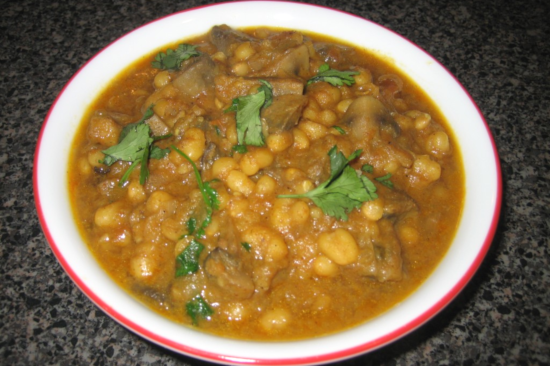Mama’s Punjabi Recipes- Soya Bean Te Khumban di Sabzi (SOYA BEAN & SAUTEED MUSHROOMS)

In the past two decades, mushrooms have become a more than a delicacy as farmers have developed ways to cultivate them in many countries in controlled environments. And this has brought the cost down and exposed many more people to the benefits of eating mushrooms.
One popular variety is the small, round, pointy type called button mushrooms, usually sold in cans. But most mushrooms available in grocery stores are the white type (technical term: Agaricus bisporus), but other common varieties are crimini and the large capped portobello. Others with exciting textures and taste are shiitake, maitake or hen-of-the-woods, oyster and enoki.
The small, one-inch cylindrical soyabean wadiyan (dumplings) are now available everywhere and are popular because of their reasonable price, spongy texture and health and protein benefits. Soyabean helps lower cholesterol, LDL and triglycerides, and is also an antioxidant, minimizing diabetes and reducing inflammation. Soyabean oil is high in beneficial omega-3 and omega-6 fatty acids and alpha-linolenic acid.
Soyabean wadiyan plump up by soaking up the flavor of the curry and the result is a soft spongy texture that gives a mouthful of juicy flavor with each bite. So, it is important to concentrate on making the curry correctly and not too watery.
Ingredients:
• 250 gm khumban (mushrooms)
• 2 cups soyabean wadiyan (soyabean lentil dumpling)
• 2 medium pyaaz (onion)
• 2 cups of pani (water)
• 3 tbsp of vegetable or olive oil
• 1 tsp tamater paste (tomato paste)
• 1 tbsp adrak (ginger) – peeled and finely chopped
• ½ teaspoon of lasan (garlic) powder (if desired)
• Spices (to taste): namak (salt), mirch (red pepper), haldi (turmeric), dhania (coriander), garam masala
Directions:
1. Clean the mushrooms with a damp paper towel. If you prefer, you can quickly dip them in water and then make sure to dry the mushrooms off completely, leaving them on a towel for some time to air out.
2. Cut off the stems of the mushrooms and aside.
3. Peel the onions, slice and keep to the side.
4. Place the wadiyan in a small pot of water and bring it to a boil for 10 to 15 minutes.
5. Test a waddi to see if it is soft to chew. If it is, drain the hot water and then immerse the boiled wadiyan in cold water to cool them down.
6. Drain the cold water, then press the wadiyan in your palms to squeeze out the soya smell and all the water.
7. In a medium frying pan, heat 2 tablespoons of oil over medium heat, then add the onions and brown them, stirring occasionally to make sure they don’t stick to the bottom. When the slightly brown, add the tomato paste, salt, pepper and garlic and stir well.
8. Pour in the wadiyan into the masala, add ½ a cup of water, add the mushrooms and stir for 2 minutes.
9. Cover the pot and let the water come to a boil. Turn the heat to low and let it simmer for five more minutes to let the flavor soak into the wadiyan.
10. Uncover the pot and check that the wadiyan have become plump and the curry is not too thin. Turn the heat off, sprinkle with garam masala and the shredded fresh dhania and let it sit uncovered.
MAMA’S TIP OF THE WEEK: FOR A FIRM DISH, CAREFULLY CLEAN MUSHROOMS WITHOUT WATER
Though white mushrooms are widely available, most people have problems when cooking them so that they are stay firm and are tasty to bite into. Often it is because they are overcooked over high heat, shed their water and become limp and then left to cool down in too much liquid.
But there is another reason that mushrooms become limp when cooked and this starts before they are cooked. Before cooking mushrooms, make sure to clean them well by dipping in water as they can hold a lot of dirt in the top cap but then, shake them and towel dry them well and leave them to air dry. This is necessary as any extra water will turn to steam and will overcook the mushrooms.

Shakuntla Malhotra is a skilled cook of Punjabi dishes made in the old-fashioned style that she learnt as a young woman in her ancestral home in Lyallpur, India (since renamed Faisalabad) before it became part of Pakistan after the Partition in 1947. People have often admired her cooking for its simplicity and taste that comes with each mouthful. Even in her late-eighties, she continues to cook daily and agreed to share her delectable Punjabi recipes for future generations.
